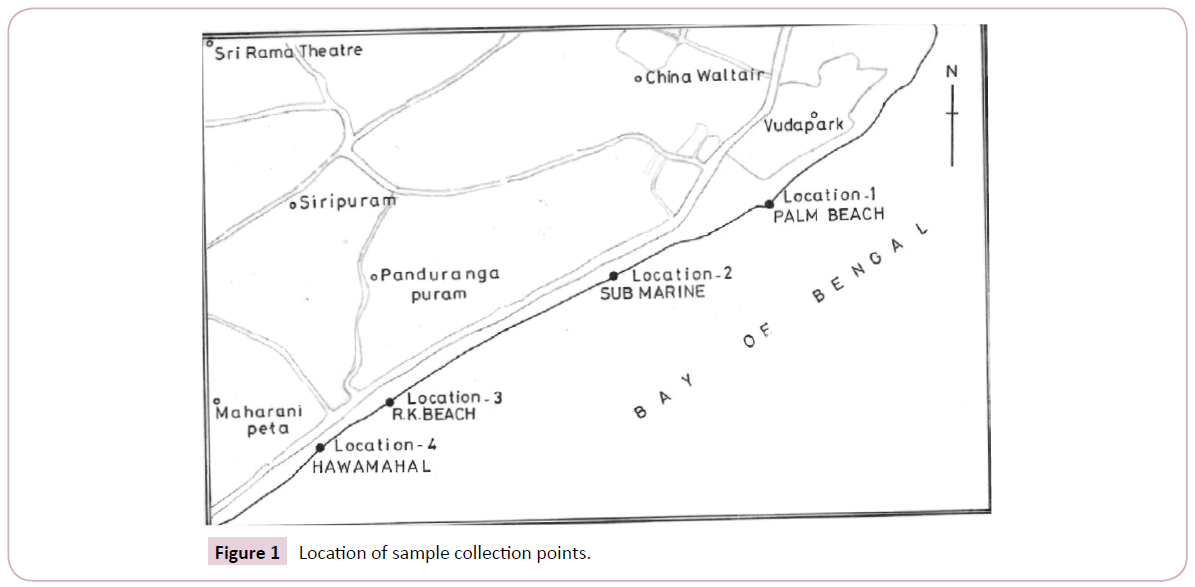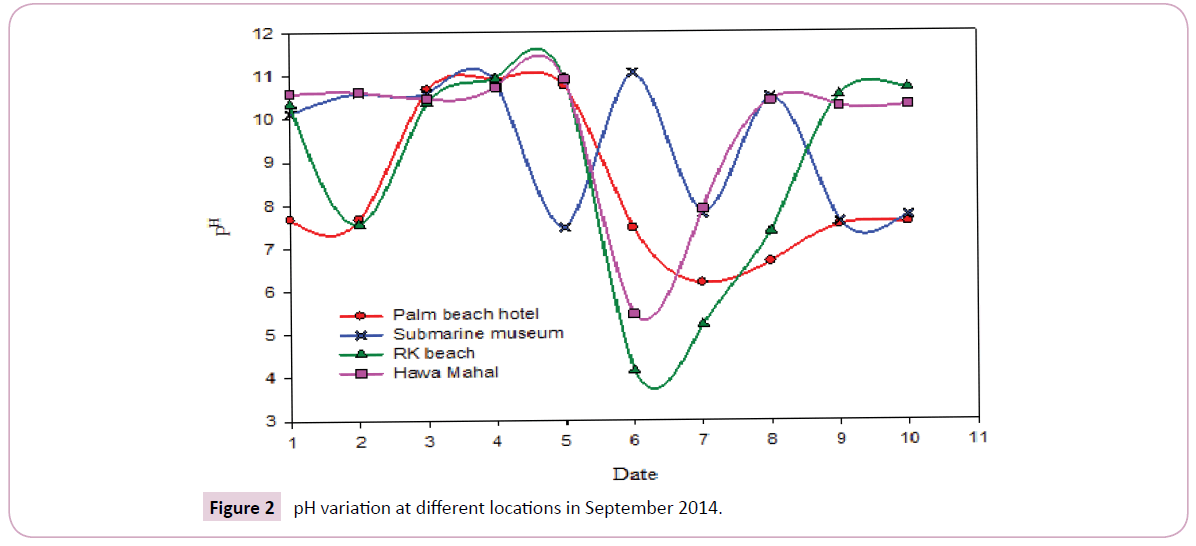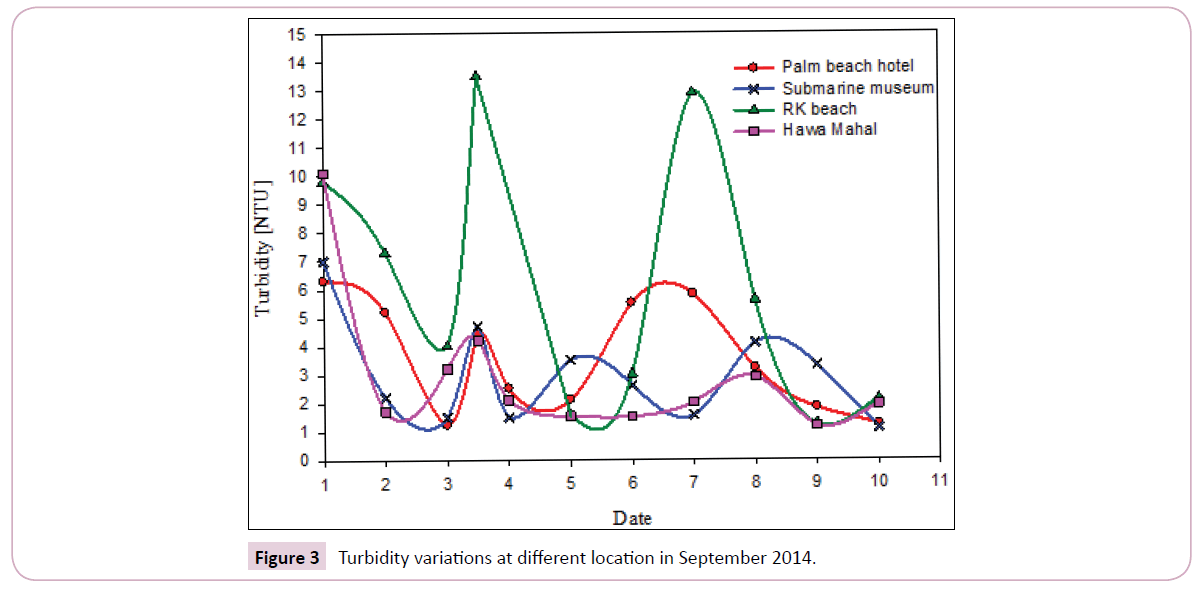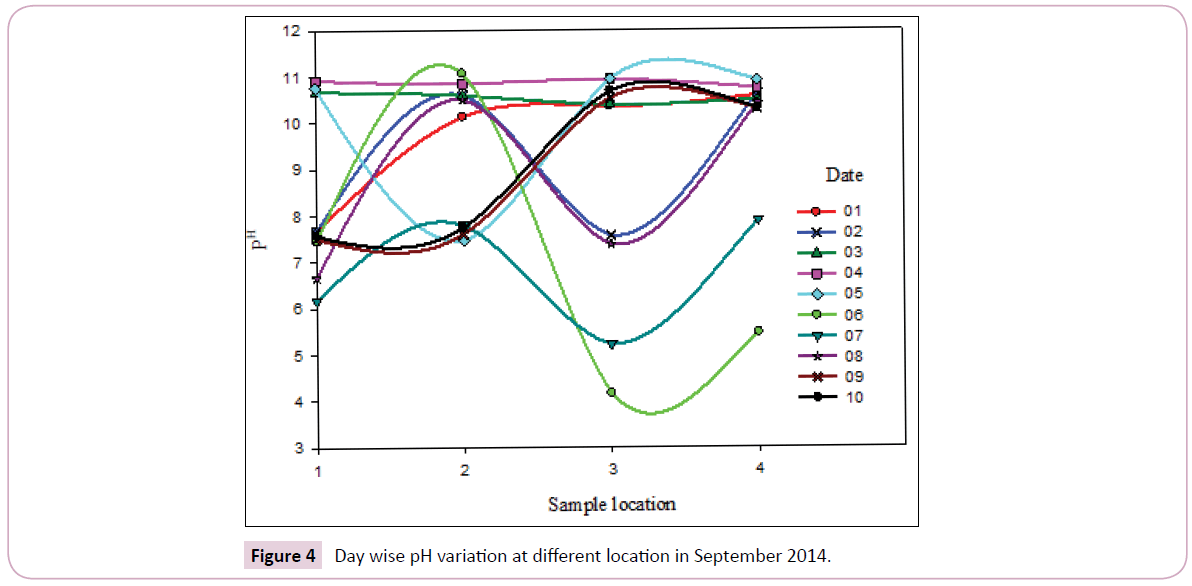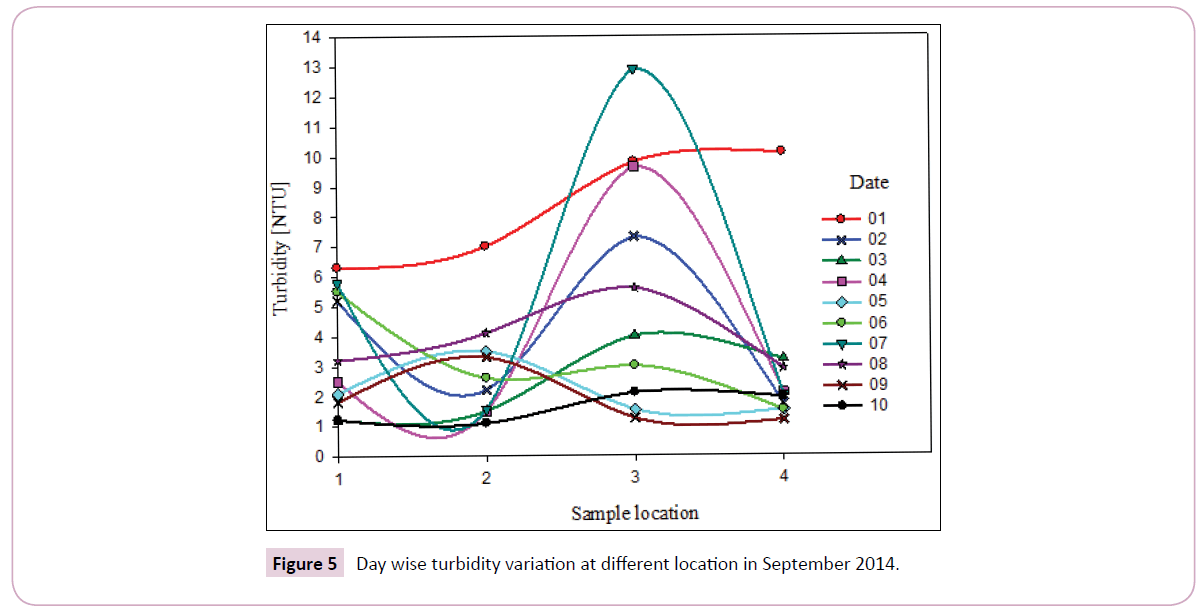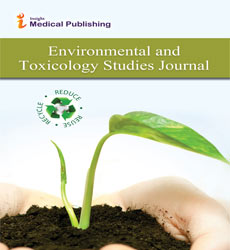Studies on Sea Water Contamination at Visakhapatnam Sea Coast in India Due to Ganesh Idol Dissolution
P Rohini Kumar1, B Gowthami2, B Sireesha2, K Gouru Naidu3 and KV Ramesh2*
1Department of Chemical Engineering, RVR & JC COE (A), Guntur-522019, India
2Department of Chemical Engineering, Andhra University, Visakhapatnam-530003, India
3Department of Engineering Chemistry, GMRIT, Rajam-532127, India
- *Corresponding Author:
- KV Ramesh
Department of Chemical Engineering
Andhra University
Visakhapatnam-530003, India
Tel: +91-9490109683
E-mail: kvramesh69@yahoo.com
Received Date: January 11, 2017; Accepted Date: February 02, 2018; Published Date: February 12, 2018
Citation: Kumar PR, Gowthami B, Sireesha B, Naidu KG, Ramesh KV (2018) Studies on Sea Water Contamination at Visakhapatnam Sea Coast in India Due to Ganesh Idol Dissolution. Environ Toxicol Stud J 2:3.
Abstract
Many festivals are celebrated in India, with full vigor and vibrant atmosphere. Among all such festivals Ganesh Chaturthi is one which generally falls either in August or September of every year. In the year 2014, this festival was celebrated on 29th August. Immersion of Ganesh Idols was carried out in Visakhapatnam, during 1st to 15th September. In this regard variations in pH and turbidity are observed at the major immersion point i.e., RK Beach along with three other sampling points.; It was observed that the pH reached a minimum of 3.5 indicating high levels of acidity, whereas turbidity became a maximum of 13 NTU at RK Beach. More or less similar trends with somewhat less intensity of variations in these parameters were noticed at the other sampling points. The present investigation thus reveals that the aquatic life would be highly affected due to this activity.
Keywords
Ganesh Chaturthi; pH; Turbidity; Visakhapatnam; Contamination
Introduction
Many festivals celebrated in India serve some important purpose. Most probably the way of conducting a particular festival has been evolved in order to meet social, emotional, environmental, psychological and other need of the society of yesteryears. One has to keep in his mind that the systems and customs have been evolved in those days where the population numbers were small. However, in the present days, with alarming and exploding population, the same customs sometimes exhibit few unwanted effects on environment. For instance, celebrating Diwali leads to release of vast quantities of polluting gases into atmosphere in addition to noise pollution [1]. In the same way, the festival known as Nagulachavithi, which is dedicated to the Sanke God, seems to cause some unwanted damage to the snakes which are key animals in protecting the agricultural produce. Likewise, another festival that is celebrated in full spirit in entire India is Ganesh Chaturthi.
This festival is celebrated by making a Ganesh idol either from earthen clay or plaster of Paris and painted and decorated very beautifully, and prayers are offered for a number of days ranging from a minimum of three to a maximum of fifteen or so, and the celebrations were closed by immersing the idol into waters. On the last day, the idol was immersed in a water body, usually a river or a tributary, a reservoir, a dam, a pond, a canal or a sea [2-14]. These idols are then subjected to dissolution in the water bodies out of which the resulting quality of these waters would have high impact on aquatic life [2-4]. In case of stationary waters, such as Hussain Sagar in Hyderabad, due to the death of aquatic animals such as fish, frog etc., foul smell comes out with intensity causing nausea to the people living and staying around [5]. In view of such situations, several agencies are working out to create awareness among the public not to use synthetic materials but to use only clay to make the Ganesh idols. With this background, it is felt to study the effect of the immersion of Ganesh idols in Visakhapatnam.
Visakhapatnam is a coastal city with a population of 2.3 million. The city is in the middle of the east coast of India and is between Kolkata and Chennai. The Eastern Naval Command has its headquarters at Visakhapatnam. The city has a natural harbor and presently one that handles millions of tons of cargo. In addition there is also a ship building unit. The city is the highly populated one in the state of Andhra Pradesh. The city was built on the coast line with Bay of Bengal. The city celebrates Ganesh Chaturthi with Great Spirit.
The festival day is arrived as from lunar calendar. In 2014, the Ganesh Chaturthi was celebrated on 29th August. Generally the immersion of the idols will be held from third day on wards. Therefore, the immersion of the idols was done from September 1 onwards. To direct the traffic and provide security, the police earmarked Rama Kirshna Beach area for this purpose. It is also known widely as RK Beach. In this regard, in the present investigation, water samples were collected from four locations from 1st September on wards up to 15th September. These samples were then analyzed for turbidity and pH. Figure 1 shows the samples collection points. A close inspection of Figure 1 reveals that location-4 is about 0.5 km away from location-3. Similarly locations 2 and 1 are 1.5 and 2.0 km away from location 3 which is the major immersion point.
Materials and Methods
Only standard procedures have been adopted for estimation of various physical and chemical parameters in the present investigation [15]. Measurement of pH and turbidity are carried out to know the quality of waters in the present case. Standard and calibrated instruments are employed for this purpose. Turbidity is obtained in NTU.
Results and Discussion
Figure 2 shows the variation of pH at the four sampling points during the period of investigation i.e. September 1 to 15.
An examination of the plot corresponding to the RK Beach, which is the immersion point of the idols, show that the pH got reduced in the major immersion days, and came down to almost 3.5 on the major immersion day i.e., on September 6. This indicates that the waters turned to be highly acidic and hence had significant impact on the aquatic life. Palm Beach and Hawa Mahal samples more or less followed similar trends however with low intensity as these two locations are placed at different ends. However, a close inspection of the plot at Submarine Museum sample indicates high levels of fluctuations in pH values. This is because, of the presence of rip currents in this region and hence severe erosion of coast is noticed. Hence, it could be representing a vigorous mixing of bulk waters and the coast waters. Figure 3 also represents similar trends as the graph is plotted to denote the variation of turbidity at each sampling point during the sampling days. It also indicates that the variation in turbidity is very high at RK Beach and the variation at other sampling points is relatively less intense.
Similar trends could be noticed from Figures 4-5 which are the graphs drawn to represent the day-wise variation of pH and turbidity at each sampling point. A close examination of the plots also reveals the same observations.
Conclusion
Experimental investigations were carried out to determine the effect of Ganesh idol immersion and subsequent dissolution in the sea waters at Visakhapatnam coast. Two parameters viz., pH and turbidity have been chosen for identifying this impact. Four sampling points have been located along the sea coast. It is observed that at the major immersion point of RK Beach there is a huge acidification of waters which slowly got reduced. Similarly high variation in turbidity is also noticed. These parameters thus indicate that there will be high impact on the aquatic life.
References
- Rao S, Gajghate DG, Gavane AG, Suryawanshi P, Chauha C, et al. (2012) Water, air quality status during Diwali festival of India: A case study. Bull Environ Contam Toxicol 89: 376-379.
- Vyas A, Mishra DD, Bajapai A, Dixit S, Verma N (2006) Environment impact of idol immersion activity lakes of Bhopal, India. Asian J Exp Sci 20: 289-296.
- Ujjania NC, Multani AM (2011) Impact of idol immersion activities on the water quality of Tapi River, Surat (Gujarat) India. Res J Biology 1: 11-15.
- Kaur R (2012) Effect of idol immersion on marine and fresh water-bodies. Advances in Applied Science Research 3: 1905-1909.
- Pears B, Sekhar MC (2016) The pathetic condition of Hussain Sagar Lake increasing of water pollution after immersion of Ganesh idols in the year, Hyderabad, Telangana, India. Int J Res Eng Appl Sci 6: 136-143.
- Watkar AM, Barbate MP (2017) Effect of idol immersion on water quality of Chandrabhaga River in Nagpur. Int J Res Biosci Agri Technol 5: 19-21.
- Das KK, Panigrahi T, Panda RB (2012) Idol immersion activities cause heavy metal contamination in river Budhabalanga, Balasore, Odisha, India. Int J Modern Eng Res 2: 4540-4542.
- Desai J, Tank SK (2010) Determination of water quality due to immersion of Ganesh idols in the river Tapti at Surat (India). J Env Res Dev 4: 999-1007.
- Malik GM, Raval VH, Zadafiya SK, Patel AV (2010) Idol immersion and physic-chemical properties of South Gujarat rivers. Current world Env 5: 173-176.
- Jhadav P, Dongare M (2009) Evaluation of dissolved oxygen and biochemical oxygen demand in ex situ Ganesh idol immersion. Nature Env Poll Technol 8: 561-564.
- Mehta P (2014) Comparative analysis of water quality parameters due to festival wastes immersion and consequential impacts in Jodhpur. Int J Geo Earth Env Sci 4: 138-148.
- Billore D, Dandawate M (2015) Environmental impact of idol immersion of Kakerpura Lake Mhow. Soc Iss Env Prob 3: 1-4.
- Shrivastava N, Mishra PK, Bajpai A (2011) Impact of idol immersion activity on the water quality of Machna River, Betul, Madhya Pradesh, India. Ind J Chem Sci 9: 1637-1646.
- Gund AS, Kakde UB (2014) Analysis of physic-chemical properties of Powai Lake during festive season in Mumbai Metropolis. Int J Res Biosci Agri Technol 2: 701-716.
- Clesceri LS, Greenberg AE, Eaton AD (1999) Standard methods for the examination of water and waste water. 20 edn. APHA, USA.
Open Access Journals
- Aquaculture & Veterinary Science
- Chemistry & Chemical Sciences
- Clinical Sciences
- Engineering
- General Science
- Genetics & Molecular Biology
- Health Care & Nursing
- Immunology & Microbiology
- Materials Science
- Mathematics & Physics
- Medical Sciences
- Neurology & Psychiatry
- Oncology & Cancer Science
- Pharmaceutical Sciences
